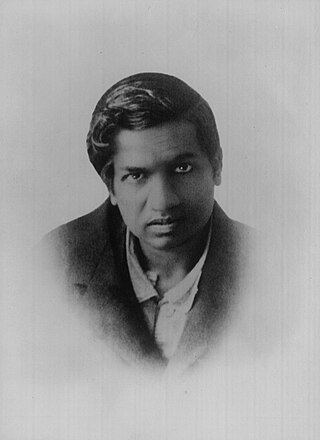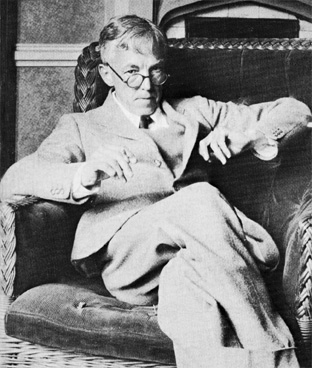Related Research Articles

Atle Selberg was a Norwegian mathematician known for his work in analytic number theory and the theory of automorphic forms, and in particular for bringing them into relation with spectral theory. He was awarded the Fields Medal in 1950 and an honorary Abel Prize in 2002.

Srinivasa Ramanujan (22 December 1887 – 26 April 1920) was an Indian mathematician. Though he had almost no formal training in pure mathematics, he made substantial contributions to mathematical analysis, number theory, infinite series, and continued fractions, including solutions to mathematical problems then considered unsolvable.

Godfrey Harold Hardy was an English mathematician, known for his achievements in number theory and mathematical analysis. In biology, he is known for the Hardy–Weinberg principle, a basic principle of population genetics.

John Edensor Littlewood was a British mathematician. He worked on topics relating to analysis, number theory, and differential equations and had lengthy collaborations with G. H. Hardy, Srinivasa Ramanujan and Mary Cartwright.

Pierre René, Viscount Deligne is a Belgian mathematician. He is best known for work on the Weil conjectures, leading to a complete proof in 1973. He is the winner of the 2013 Abel Prize, 2008 Wolf Prize, 1988 Crafoord Prize, and 1978 Fields Medal.

Terence Chi-Shen Tao is an Australian mathematician who is a professor of mathematics at the University of California, Los Angeles (UCLA), where he holds the James and Carol Collins chair. His research includes topics in harmonic analysis, partial differential equations, algebraic combinatorics, arithmetic combinatorics, geometric combinatorics, probability theory, compressed sensing and analytic number theory.
194 is the natural number following 193 and preceding 195.

Peter Clive Sarnak is a South African-born mathematician with dual South-African and American nationalities. Sarnak has been a member of the permanent faculty of the School of Mathematics at the Institute for Advanced Study since 2007. He is also Eugene Higgins Professor of Mathematics at Princeton University since 2002, succeeding Sir Andrew Wiles, and is an editor of the Annals of Mathematics. He is known for his work in analytic number theory. He also sits on the Board of Adjudicators and the selection committee for the Mathematics award, given under the auspices of the Shaw Prize.

Amir Dan Aczel was an Israeli-born American lecturer in mathematics and the history of mathematics and science, and an author of popular books on mathematics and science.
In mathematics, Ramanujan's congruences are some remarkable congruences for the partition function p(n). The mathematician Srinivasa Ramanujan discovered the congruences

Kannan Soundararajan is an Indian-born American mathematician and a professor of mathematics at Stanford University. Before moving to Stanford in 2006, he was a faculty member at University of Michigan, where he had also pursued his undergraduate studies. His main research interest is in analytic number theory, particularly in the subfields of automorphic L-functions, and multiplicative number theory.

Gil Kalai is an Israeli mathematician and computer scientist. He is the Henry and Manya Noskwith Professor Emeritus of Mathematics at the Hebrew University of Jerusalem, Israel, Professor of Computer Science at the Interdisciplinary Center, Herzliya, and adjunct Professor of mathematics and of computer science at Yale University, United States.

Kathrin Bringmann is a German number theorist in the University of Cologne, Germany, who has made fundamental contributions to the theory of mock theta functions.
In mathematics, umbral moonshine is a mysterious connection between Niemeier lattices and Ramanujan's mock theta functions. It is a generalization of the Mathieu moonshine phenomenon connecting representations of the Mathieu group M24 with K3 surfaces.
In number theory, a branch of mathematics, Ramanujan's ternary quadratic form is the algebraic expression x2 + y2 + 10z2 with integral values for x, y and z. Srinivasa Ramanujan considered this expression in a footnote in a paper published in 1916 and briefly discussed the representability of integers in this form. After giving necessary and sufficient conditions that an integer cannot be represented in the form ax2 + by2 + cz2 for certain specific values of a, b and c, Ramanujan observed in a footnote: "(These) results may tempt us to suppose that there are similar simple results for the form ax2 + by2 + cz2 whatever are the values of a, b and c. It appears, however, that in most cases there are no such simple results." To substantiate this observation, Ramanujan discussed the form which is now referred to as Ramanujan's ternary quadratic form.
Jacob Tsimerman is a Canadian mathematician at the University of Toronto specialising in number theory and related areas. He was awarded the SASTRA Ramanujan Prize in the year 2015 in recognition for his work on the André–Oort conjecture and for his work in both analytic number theory and algebraic geometry.
Miranda Chih-Ning Cheng is a Taiwanese-born and Dutch-educated mathematician and theoretical physicist who works as an associate professor at the University of Amsterdam. She is known for formulating the umbral moonshine conjectures and for her work on the connections between K3 surfaces and string theory.
Jack A. Thorne is a British mathematician working in number theory and arithmetic aspects of the Langlands Program. He specialises in algebraic number theory.
Amanda L. Folsom is an American mathematician specializing in analytic number theory and its applications in combinatorics. She is a professor of mathematics at Amherst College, where she chairs the department of mathematics and statistics.
Yunqing Tang is a mathematician specialising in number theory and arithmetic geometry and an Assistant Professor at University of California, Berkeley. She was awarded the SASTRA Ramanujan Prize in 2022 for "having established, by herself and in collaboration, a number of striking results on some central problems in arithmetic geometry and number theory".
References
- ↑ Fall 2019, Thomas Jefferson Professor of Mathematics: https://uva.theopenscholar.com/ken-ono/ Archived 2022-05-29 at the Wayback Machine
- 1 2 3 4 5 6 7 8 9 10 11 12 13 "Vitae" (PDF). Ken Ono. Archived (PDF) from the original on March 26, 2022. Retrieved November 9, 2021.
- ↑ Bach, John (April 2013), "Getting to know Ono", UC Magazine, archived from the original on 2015-04-02, retrieved 2015-01-16
- ↑ Archives, Cycling (2019-06-26). "Ken Ono". Cycling Archives. Archived from the original on 2023-09-30. Retrieved 2024-03-30.
- ↑ Ken Ono at the Mathematics Genealogy Project
- 1 2 Saikia, Manjil (23 February 2015). "In conversation with Prof. Ken Ono: Gonit Sora". Gonit Sora . Archived from the original on 15 March 2015. Retrieved 16 March 2015.
- ↑ Bahorsky, Russ (2022-01-05). "Faculty Spotlight: Math Professor Is UVA Swimming's Secret Weapon". UVA Today. Archived from the original on 2023-10-01. Retrieved 2024-03-30.
- ↑ Peterson, Ivars (13 December 2002). "Power in partitions". Science News . Archived from the original on 29 May 2022. Retrieved 29 May 2022.
- ↑ Kavassalis, Sarah. "Finite formula found for partition numbers". The Language of Bad Physics. Archived from the original on 18 February 2011. Retrieved 1 March 2011.
- ↑ Griffin, Michael J.; Ono, Ken; Warnaar, S. Ole (2014). "A framework of Rogers–Ramanujan identities and their arithmetic properties". Duke Mathematical Journal. 165 (8). arXiv: 1401.7718 . doi:10.1215/00127094-3449994. S2CID 119616304.
- ↑ "Mother lode of mathematical identities discovered, Discover". Archived from the original on 2015-01-07. Retrieved 2014-12-27.
- 1 2 Duncan, John; Griffin, Michael J.; Ono, Ken (2015). "Proof of the Umbral Moonshine Conjecture". Research in the Mathematical Sciences. 2. arXiv: 1503.01472 . doi: 10.1186/s40687-015-0044-7 . S2CID 43589605.
- ↑ Griffin, Michael J.; Ono, Ken; Rolen, Larry; Zagier, Don (2019). "Jensen polynomials for the Riemann zeta function and other sequences". Proceedings of the National Academy of Sciences, USA. 116 (23): 11103–11110. arXiv: 1902.07321 . Bibcode:2019PNAS..11611103G. doi: 10.1073/pnas.1902572116 . PMC 6561287 . PMID 31113886.
- ↑ Bombieri, Enrico (2019). "New progress on the zeta function: From old conjectures to a major breakthrough". Proceedings of the National Academy of Sciences, USA. 116 (23): 11085–11086. Bibcode:2019PNAS..11611085B. doi: 10.1073/pnas.1906804116 . PMC 6561272 . PMID 31123152.
- ↑ "- Emory news, 11 January 2018". Archived from the original on 30 May 2022. Retrieved 29 May 2022.
- ↑ "- Atlanta Journal Constitution, 25 June 2021". Archived from the original on 29 May 2022. Retrieved 29 May 2022.
- ↑ "- University of Virginia news, 5 January 2022". Archived from the original on 21 May 2022. Retrieved 29 May 2022.
- ↑ "- National Public Radio, 12 March 2022". Archived from the original on 29 May 2022. Retrieved 29 May 2022.
- ↑ - Swim Swam magazine, 10 August 2022
- ↑ Douglass K, Lamb A, Lu J, Ono K, Tenpas W, (March 2024). "Swimming in Data" - Mathematical Intelligencer, 24 March 2024 Archived 28 March 2024 at the Wayback Machine , doi:10.1007/s00283-024-10339-0.
- ↑ Ono, Ken; Aczel, Amir D. (20 April 2016). My Search for Ramanujan: How I Learned to Count. Springer. ISBN 978-3-319-25568-2. Archived from the original on 28 March 2024. Retrieved 28 March 2024.
- ↑ Stenger, Allen (July 7, 2016). "review of My Search for Ramanujan: How I Learned to Count by Ken Ono and Amir Aczel". MAA Reviews, Mathematical Association of America (MAA).
- ↑ "Miller 64 reacts to Bud Light's new 80-calorie beer in new ad". Adweek . 8 February 2022. Archived from the original on 7 July 2022. Retrieved 28 May 2022.
- ↑ "Infinity Arts Foundation". 29 May 2022. Archived from the original on 28 May 2022. Retrieved 29 May 2022.
- ↑ "Athlete Profile:Ken Ono". World Triathlon Championship Series. Archived from the original on August 3, 2021. Retrieved November 9, 2021.
- ↑ Date, Upcoming Due (2024-03-30). "The Presidential Early Career Award for Scientists and Engineers: Recipient Details". NSF. Archived from the original on 2024-03-30. Retrieved 2024-03-30.
- ↑ - IAS biography Archived 2022-05-31 at the Wayback Machine . retrieved 2022-05-29.
- ↑ David and Lucile Packard Foundation website Archived 2022-05-23 at the Wayback Machine , retrieved 2022-05-29.
- ↑ - Penn State news, retrieved 2022-05-29.
- ↑ - John S. Guggenheim Foundation website Archived 2022-05-29 at the Wayback Machine , retrieved 2022-05-29.
- ↑ - NSF press release Archived 2022-07-07 at the Wayback Machine , retrieved 2022-05-29.
- ↑ List of Fellows of the American Mathematical Society Archived 2012-12-05 at archive.today , retrieved 2013-03-20.
- ↑ University of Chicago news story Archived 2023-03-19 at the Wayback Machine , retrieved 2023-03-13.
- ↑ "2023 Effie Award annoucement". 6 July 2023. Archived from the original on 7 July 2023. Retrieved 6 July 2023.
- ↑ Indian Academy of Sciences Announcement Archived 2024-01-10 at the Wayback Machine , retrieved 2024-01-10.